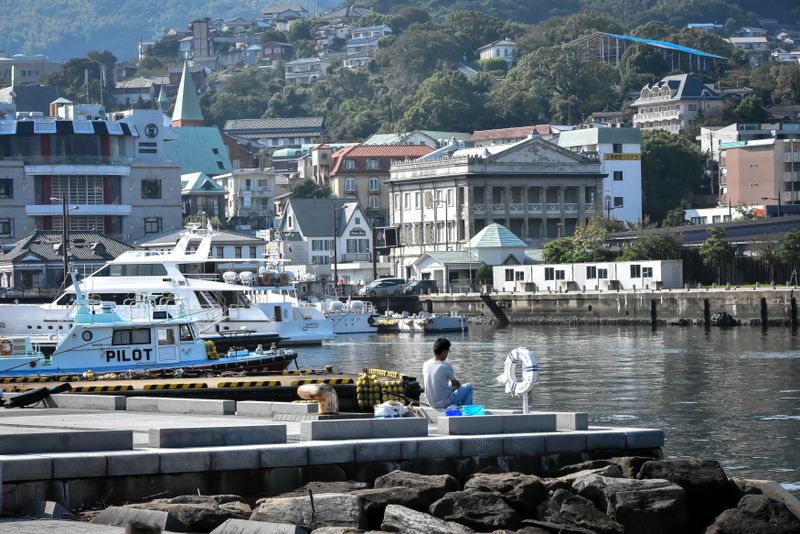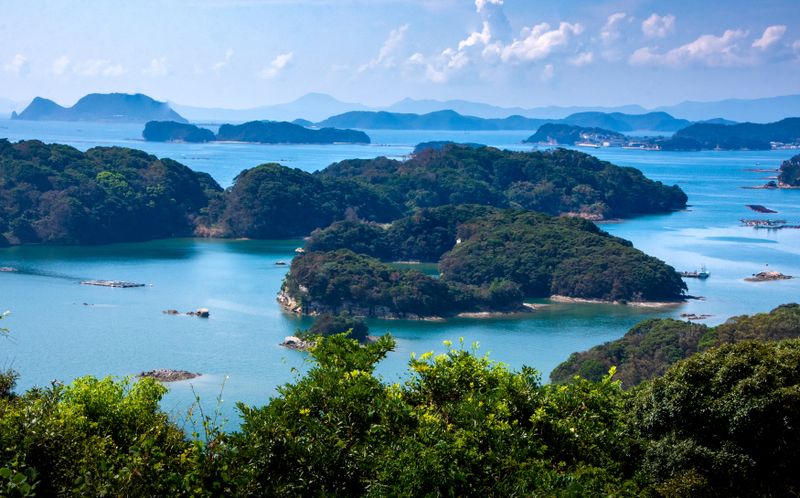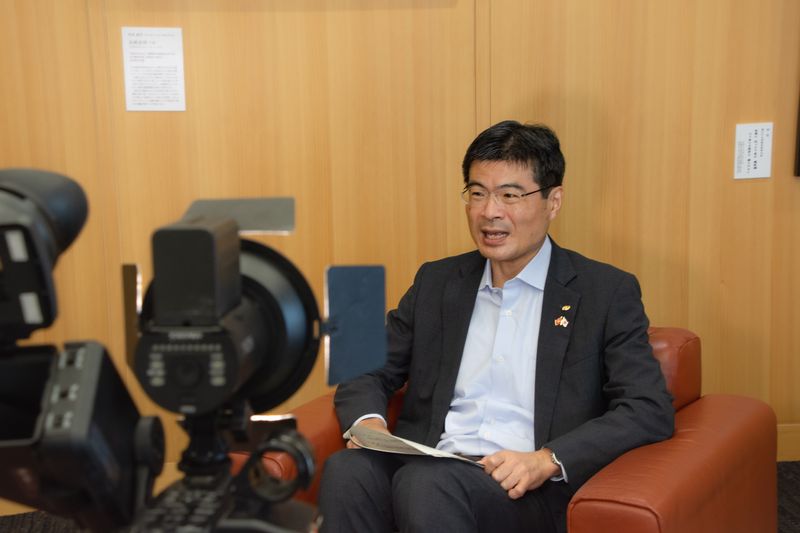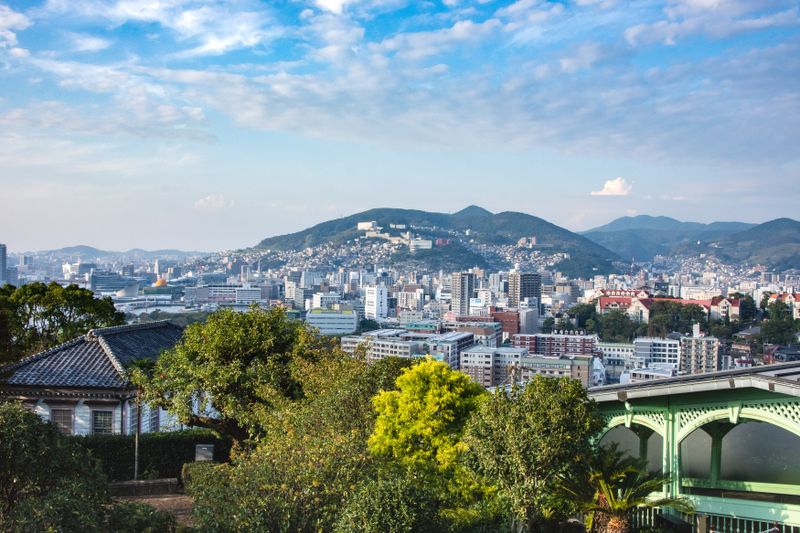Oct 13, 2020
A view to Nagasaki: Setting the scene for international exchange

When visiting Nagasaki you have to keep reminding yourself to pick the lower half of your jaw up from the floor after it has dropped yet again from the sight of another, well, jaw-dropping view. Or was it from all the puffing and panting after yet another steep climb to get there? Probably both.
And there’s so many of them, views that is, which not only presents plenty of stiff climbing but also a stiff challenge when you’ve been charged with finding “the” Nagasaki view. The scene-setter for broadcasts from the region.
Team City-Cost is in the prefecture, on the island of Kyushu in southwestern Japan, helping to conduct a press tour for journalists covering the efforts of one of the universities here in attracting international students from Vietnam.
The University of Nagasaki is continuing to build on a history of exchange between the region and Vietnam that dates back to the late-16th century when Japan’s “Shuinsen” trading ships, bearing the red-seal of approval from the Tokugawa shogunate, fanned out from Nagasaki to trade with the rest of Asia, with many ships bound for Vietnam.
400 years and a Japanese-Vietnamese coupling that is said to be the first international marriage in Japan later and today there are over 2,700 Vietnamese nationals resident in the prefecture, according to recent statistics.
"For Nagasaki Prefecture, this exchange with Vietnam -- the development of businesses and systems to facilitate the welcoming of students and workers from Vietnam -- is very important,” the university’s president Tsutomu Kimura, told reporters during the tour.
“For the local economy, Vietnam could be our most important partner."
Is this to say that bilateral relations and the future prosperity of Nagasaki could be adversely affected if I don’t get this image right then? That’s probably overstating it but trying to capture Nagasaki in a single image does come with a certain amount of pressure.
Perhaps a picture of one of those ships will make for an appropriate scene-setter.
Visitors to the region can find a replica Shuinsen ship at the Kujukushima Pearl Sea Resort. The gentrified spot -- a departure point for pleasant cruises and point of anchor for a flotilla of weekend bateaux -- is a far cry from the booming shipyards and military-grade ocean goers in central Sasebo City, nearby.
Still, it’s from Hirado, just north of here, that 90 percent of Japan’s Shuinsen headed out into the open ocean, although this one we’re all having trouble fitting into the framing of our cameras.
Observation points in the hills above the resort offer what must be one of the most stunning views to be had in these parts, even if in the blazing sun it appears more South East Asia than it does Nagasaki -- the landscape of rugged coastline and emerald green islands surrounded by turquoise waters that make up Kujukushima. That’s 208 islands, according to a 2001 survey. (In the naming of the area though someone must have gotten bored at counting them all and stopped at 99 -- “kujuku.”)

(Lost count? Just some of the islands of Kujukushima, Nagasaki Prefecture)
The islands of Kujukushima make up around half of those that occupy the Saikai National Park in Nagasaki Prefecture, which includes the five main islands of the Goto chain. The bay at Kujukushima itself was welcomed in 2018 as a member of “The club of the most beautiful bays of the world,” which includes among its “membership” Vietnam’s Hạ Long Bay.
Island life, culture and geography is taken seriously in these parts and during a round of interviews our journalists speak with the professor heading up The University of Nagasaki’s “Shimanavi” program, at the Sasebo campus.
Compulsory for all students, the program sees Nagasaki’s islands as an extension of the university campus with students and locals teaming up to find innovative solutions to social challenges facing islanders.
With all these islands at their disposal however, it draws an ironic smile to think of authorities in Nagasaki ordering one to be built from scratch in order to house the early Portuguese traders, as they did with Dejima in downtown Nagasaki (the city) in the early 17th century.
During the interviews I managed to pull aside Le Trung Hai, a student from Vietnam’s Da Nang province, now in his fourth year of study at the university, to talk about life as a foreigner in the region.
“It's an open town, isn't it? There are lots of foreigners here, particularly in Sasebo where the U.S military has a base,” he tells me.
“Actually, I made friends with people who were working on the base and sometimes we would all go together to the gaijin bars in Sasebo. It feels like everyone is welcome here.”
For most visitors to the region it’s likely to be in the city of Nagasaki, however, where they, and perhaps we, will find the most iconic views and the scene-setter for this tour. In fact, many people will have seen one of them without having had to set foot in Japan -- the Peace Park and its view to Seibo Kitamura’s Nagasaki Peace Statue in the city’s Urakami neighborhood, the hypocenter of the atomic bomb explosion.
The downtown Nagasaki tour itinerary includes a visit to the prefectural government offices housed in a shiny new facility just south of Nagasaki train station, and an interview with Nagasaki Vice Governor Ken Hirata who further stressed the importance of ties with Vietnam.
“Businesses and universities within Nagasaki, people working in education and schools, are actively getting to grips with the exchange with Vietnam,” the vice governor told tour reporters.
“For the development of Nagasaki the exchange with Vietnam is something I think that we cannot afford to miss.”
Among the efforts to facilitate further exchange between Nagasaki and Vietnam has been the opening of a Japanese-language school exclusively for Vietnamese students. Classes got underway at the GOTO Japanese Language School, located on the Goto island chain east of mainland Nagasaki, in April 2020 and at the time writing was educating 16 students.
“For studying Japanese it's a really great place, I think,” explained Goto Mayor Ichitaro Noguchi of study on the islands.
“OK, it doesn't have the convenience that comes with living in an urban area but it’s an environment in which you can concentrate on your studies without so many distractions, and you’ve got kindness of the local people around you -- a kindness that can’t be found in the city.”

(Goto Mayor Ichitaro Noguchi talks island life with a reporter from Vietnam in downtown Nagasaki)
Just as the bilateral exchange is seen here as something not to be missed out on, nor were we allowed to miss out on the view from atop the government office building. From here, looking over the Port of Nagasaki, we were asked to spot a number of the city’s icons, including UNESCO World Heritage-listed sites Oura Cathedral (The Hidden Christian Sites in the Nagasaki Region), Glover House and the Mitsubishi Giant Cantilever Crane (Sites of Japan's Meiji Industrial Revolution).

(Nagasaki Vice Governor Ken Hirata addresses the cameras during the press tour)
From this lofty perch we can also see the city’s new Shinkansen bullet train terminal being readied for the arrival of services from the Kyushu Shinkansen Nagasaki route, set for arrival in 2022. Few people we spoke to on the streets though seemed enthusiastic about the need for a faster connection to the rest of Japan. Still today, the region appears to have its gaze fixed toward that which might be arriving from overseas.
Up here on the roof of the city office though, the expat in Japan can’t help but wonder if the colorful cast of international rogues, traders, gun runners, missionaries and diplomats that has washed up on the shores around Nagasaki over the centuries ever had to come to a place like this to apply for a “gaijin card.”
For a closer look at Nagasaki’s distant icons seen from our downtown lookout we take our tour to the city’s southern neighborhoods, once home to the Western diplomats and industrialists who settled here after Japan once again began opening its doors to the wider world in the mid-19th century.

(View over downtown Nagasaki from Glover Garden)
Glover Garden -- named after Thomas Blake Glover, the Scottish trader and industrialist who was something of a pioneer of the expat scene in Japan -- is the centerpiece of this area of Nagasaki, with its collection of relocated and restored Western homes that graciously make their way up the Minami-Yamate hillside location.
At the top I thought for a moment that I’d found “the” Nagasaki that could set the scene for the tour. After all, it's all laid bare here -- the well-to-do remnants and twee flower beds of Western settlement, the harbor and its booming ships yards preparing water-borne trade, the shopping malls of downtown, church spires, history's dark secrets and appalling decisions laid out for all to see and turned into moving monuments. Nagasaki, looking like a Rio de Janeiro of the Far East, crawling colorfully up the surrounding hillsides.
The city’s mad mix of humanity coming and going over the centuries may appear chaotic on paper, but up here in front of you it arrests with its familiarity as much as it washes away all the tired neon-decorated stereotypes of urban Japan that the expat like me might have acquired over the years.
But as much as my jaw dropped at the top of Glover Garden, it did do the same thing when confronted with the delicious yet daunting-in-volume dish of signature Nagasaki champon that was served at lunch soon after our arrival in town. And the same again when I saw the city lights dazzle from atop Mt. Inasayama. And on many other occasions.

(Downtown Nagasaki from the observation deck on Mt. Inasayama)
No, with so many vistas and so much history and culture tumbling around around the region, it’s a Sisyphean task trying to capture Nagasaki in a single frame -- as soon as you think you might have done it, you turn a corner, crest a hill, visit at another time of day only to find a scene which rivals the last or at least contradicts it.
Not a scene but a moment then, back at the university campus and another round of interviews with professors but this time Ngo Thi Linh Chi, another Vietnamese student, is in the room awaiting her turn in front of the cameras. When it comes our reporters and camera crew appear at their most excited, at the same time as appearing at their most relaxed just as they did with Le Trung Hai.
That the students fielded far more questions and commanded the most space on memory cards was, of course, in part down to both parties not having to wrestle with a foreign-language. The rest though, I’m sure, was down to being in the presence of something familiar, a comforting sense of home and the reassurance that comes with finding others in the same situation.

(Vietnamese students Le Trung Hai (left) - Department of Business Administration, Ngo Thi Linh Chi (right) - Department of Nutrition and Health, The University of Nagasaki)
The university’s next round of international student recruits, fresh off the boat, will likely take an interaction like this for granted if they pay it any particular regard at all, but for the tired expat, this could be Nagasaki at its finest -- a place where from the charming chaos of cultures combined and so far from home, something familiar and warm reveals itself to let you know that everything is going to be OK.
During our visit to Glover Garden I picked up in the gift shop a copy of “The Nagasaki British Consulate 1858 - 1955” by Brian Burke-Gaffney, a Canadian professor based in Nagasaki.
Burke-Gaffney’s book details the establishment of the Nagasaki British Consulate in 1859 and the diplomatic servants who occupied it over the years until being forced to abandon their post during the war.
Looking among the pages to get some sense of how my fellow country people felt upon their arrival in Nagasaki, I was drawn to one quote in particular, perhaps in part for its perfect example of British reserve. It comes from a Mrs. Hodgson, wife of C. Pemberton Hodgson who was appointed acting British consul in Nagasaki in 1859.
In a letter to her mother Mrs. Hodgson describes her early circumstances in Nagasaki, at the site of the British consulate,
“On the whole my impression was that I would like the place. … I felt I should not be an exile here,” she wrote.
I couldn’t agree more Mrs. Hodgson. As much as it could be possible for the foreigner to feel like they really belong anywhere in Japan, it must surely be here, in Nagasaki, the setting for this tour.
Links:
The University of Nagasaki homepage (English)
The University of Nagasaki homepage (Vietnamese)
GOTO Japanese Language School (Vietnamese)



0 Comments